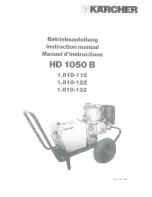
9
Important Trailer Safety Information
Maintenance
Keep ball pocket and mechanism clean. The following
procedures should be performed at least annually:
•
Check set screw torque Grease ball pocket
•
Oil pivot points with SAE 30 wt. motor oil
•
Inspect retaining pin and replace if necessary
Operation
To Couple:
1.
Block trailer wheels.
2.
Align hitch ball beneath coupler.
3.
Open coupler locking lever. While holding locking
lever open, lower the coupler over the hitch ball
until ball is fully seated into the ball pocket.
4.
If locking lever is pinned open, remove pin. Move
locking lever to the closed position. Check that the
latch is engaged by lifting up on back of locking
lever. Also, check that the hitch ball is fully seated
and ball clamp is below the ball. If the ball is not
seated with lever in the closed position and latch
engaged, DO NOT TOW.
Repeat the above steps.
5.
OPTIONAL: Place a 5/16” pin or lock in hole shown
To Uncouple:
1.
Block trailer wheels.
2.
Open locking lever. While holding locking lever fully
open, raise trailer off of hitch ball.
NOTE: A 5/16” diameter pin can be used to hold the
locking lever open.
Hitch Coupler Troubleshooting
If the coupler becomes damaged it must be repaired or
replaced before towing. When the coupler is placed on
the ball, the latch should close firmly. Keep the latch
mechanism lightly oiled and clean. Items to check for
are as follows:
1.
Latch does not grasp ball securely:
•
Check the ball size. Make sure the ball and
coupler are the same size.
2.
Latch does not snap into full latch position:
•
Check adjustment. Latch mechanism may be
too tight.
•
Check to see that the coupler housing has not
been damaged, keeping the ball hitch from
fitting completely into the housing as designed.
3.
Keep the tongue blocked up when not in use so the
coupler and mechanism are not in the ground
being exposed to dirt and moisture.
4.
Apply a small amount of an automotive grease to
the ball before hitching coupler to prevent wear of
the two parts during towing.
5.
Make sure the latch safety pin is in position before
towing.
Coupler & Ball Engagement
If the coupler and towing ball resist attempts to make
engagement, do not force latch assembly. Instead,
check the ball diameter to verify that it conforms to
Society of Automotive Engineers (SAE) specifications.
Standard two-inch diameter ball should be within the
limits of 2.000-inches to 1.970-inches. Balls larger than
2.000- inches will not readily fit the coupler. A two-piece
coupler ball is not recommended.
If the coupler becomes damaged it must be repaired or
replaced before towing. When the coupler is placed on
the ball, the latch should close firmly. Keep the latch
mechanism lightly oiled and clean.
Improper engagement of the coupler and ball can
cause damage if the vehicles separate in transit, thus,
caution must be exercised to insure a secure hook-up.
Lower the coupler onto the ball with the coupler latch in
the vertical position. Continue to lower the trailer
tongue until the jack clears the ground, then flip the
coupler latch to its locked (horizontal) position. At this
point visually observe that the ball is fully engaged in
the ball hitch. An even better check to make sure the
two are fully engaged is to raise the tongue of the trailer
again using the jack. Raise until the ball hitch connec-
tion starts to raise the rear of the tow vehicle. If the
connection was not properly made, the ball and socket
will separate as the tongue of the trailer is raised.
Karcher Trailer Operator’s Manual 9.800-199.0 - E










































